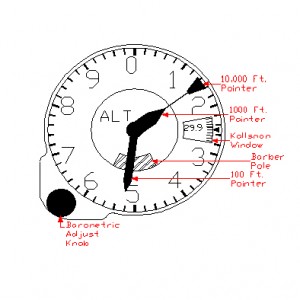How to Read a 3 Pointer Altimeter
A three-pointer altimeter, as its name implies, has three different pointers on the front dial. They are the 100-foot pointer, the 1000-foot pointer, and the 10,000-foot pointer. The medium length pointer is the 100-foot pointer, the shortest pointer is the 1000-foot pointer, and the longest pointer is the 10,000-foot pointer. The altimeter dial has 10 major indices numbered 0 through 9. In between each major indice are 4 minor indices. The value of these indices is dependent on the pointer being read. When reading the 100-foot pointer each minor indice equals 20 feet, each major indice equals 100 feet. When reading the 1000-foot pointer each minor indice is equal to 200 feet, each major indice is equal to 1000 feet. When reading the 10,000-foot pointer each minor indice is equal to 2000 feet, each major indice is equal to 10,000 feet. The altimeter in figure 1 is indicating 11,520 feet and is read as follows:
The 10,000 foot pointer is past the 1 and not yet up to the
2 and so it is read as: 1 x 10,000 = 10,000 +
The 1,000 foot pointer is past the 1 and not yet up to the
2 and so it is read as: 1 x 1,000 = 1,000 +
The 100-foot pointer is 1 minor indice past the 5 and so
Therefore, it is read as: 5.2 x 100 = 520
The indicated altitude is the sum of the pointers: 11,520
Figure 1: Three-Pointer Altimeter



